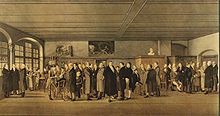Basel artist society
The first Basler Künstlergesellschaft ( BKG ) was informally founded in Basel in 1812 . In 1814 it set itself the following goals in the statutes: «To unite in friendly circles in order to talk to one another mainly about objects of art. [....] Encouraging the sense of art, spreading good taste in general, making local artists and their work known, mutual instruction on art objects. "
history

The BKG founding members included its first president Peter Vischer-Passavant (1779–1851) and Marquard Wocher . It represented Basel's oldest organized association in which artists and art lovers were united. In the political turmoil of the 1830s, the BKG lost its importance. Many members died, the offspring was rare, needs changed and so the society dissolved in 1839. Their ownership passed to the Basler Kunstverein, founded in 1839 .
In 1842, the BKG was founded for the second time. Its president was the councilor and businessman and art-loving amateur Johann Jakob Im Hof -Forcart. The Basler Ferry Company was founded to finance a long-awaited “artist house” . Their flourishing means of transport connected Greater and Small Basel . The request was granted and at the end of November of the same year the Harzgraben ferry, as the connection was now officially called, was able to start operating. The ferry was christened "Rheinmücke". In 1862 the artist society opened a second ferry connection, which connected the Grossbasler Totentanz with the Kleinbasler Kaserne , so today's Klingental Ferry . As hoped, the ferries paid off.
Since neither the Basler Kunstverein nor the BKG had enough members to exist individually, the second merger took place in 1864. The fortune from the ferry earnings flowed into the coffers of the art association. With his profit, the art gallery designed by Johann Jakob Stehlin was built on the Steinenberg and opened in 1872.
JJ Im Hof took over the presidency of the art association and became the legendary guide into a new, more art-friendly Basel art era. At the turn of the century and until the Basler Kunstverein developed exhibition activities geared towards the cultivation of contemporary art, it was the artists' society in which the distinguished artists gathered.
In the courtyard and the BKG campaigned for the St. Jakobs monument and the Hebel monument to be realized. In addition, the artists from the BKG shaped the public and semi-public space of Basel with important works such as the painting of the town hall and the frescoes in the main post office .
In the long run it was difficult for the artist members of the association to accept the preponderance of lay people on the board and management. In 1888, mainly at the instigation of Hans Sandreuter , the third re-establishment of the BKG, which still exists today. The BKG had its seat in the basement of the reading society in the so-called "Art Hole", where the art exhibitions of its members also took place. Sandreuter was its president from 1888 to 1894. Likewise led Wilhelm Balmer , Emil Beurmann , Emil Schill , Burkhard Mangold and art painter and teacher Albrecht Mayer the Bureau until the 1920s. Cuno Amiet , Max Buri and Giovanni Giacometti joined the BKG as prominent foreign members . Almost all of the then modern Basel artists were members.
Membership was not only open to visual artists, but poets and composing musicians were also accepted. In 1910, younger artists pushed forward, who naturally joined the unionized GSMBA founded in 1865 and thus also promoted the great turnaround in the art association towards opening up against modernity.
On the occasion of the 200th anniversary of the Basler Künstlergesellschaft, an exhibition on its history was held in 2014 in the Basel University Library .
Today the BKG has around 60 active and 100 passive or benefactor members. Its purpose is to promote and mediate the fine arts, with a focus on contemporary work. As at the beginning, it offers a platform for contacts between artists from all fields and art lovers. The joint annual meals, excursions and guided tours as well as studio visits are intended to promote the exchange between the active and the passive members.
literature
- Dorothea Christ : Painter and sculptor of the Basler Künstlergesellschaft 1850–1950. Exhibition catalog. Kunsthalle Basel, 1980, ISBN 3-905057-20-4 .
Web links
- Basel artist society
- Basler Künstlergesellschaft In: Basler Stadtbuch
- Karen Gehrig: Basler Künstlergesellschaft In: Tageswoche , December 4, 2014